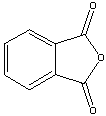
NTP Study Reports

NTP Study Reports
Home » Study Results & Research Projects » NTP Study Reports » All Long-Term Reports » Abstract for TR-159 - Phthalic Anhydride

| Chemical Formula: C8H4O3 | - | 3D Structure* | |
|---|---|---|---|
| *To view structure, download free Chemscape Chime Plug-in | |||
Phthalic anhydride is an important chemical intermediate in the plastics industry. From it are derived numerous phthalate esters that function as plasticizers in synthetic resins. Phthalic anhydride itself is used as a monomer for synthetic resins such as glyptal, the alkyd resins, and the polyester resins. Phthalic anhydride is a precursor of anthraquinone, phthalein, rhodamine, phthalocyanine, fluorescein, and xanthene dyes. Reaction of phthalic anhydride with ammonia yields phthalimide, a useful reagent in the synthesis of primary amines, the agricultural fungicide phaltan, and thalidomide. Other reactions yield phenolphthalein, benzoic acid, phthalylsulfathiazole (an intestinal antimicrobial agent), and terephthalic acid.
A bioassay of phthalic anhydride for possible carcinogenicity was conducted by administering the test chemical in feed to F344 rats and B6C3F1 mice.
Groups of 50 rats of each sex were administered the test chemical at one of two doses, initially either 25,000 or 50,000 ppm, for 32 weeks. Because of excessive depressions in the amount of body weight gained in the dosed groups, the doses for the males were then reduced to 12,500 and 25,000 ppm, respectively, and the doses for the females were reduced to 6,250 and 12,500 ppm. Administration of the test chemical at the lowered doses was continued for 72 weeks. The time-weighted average doses for the males were either 16,346 or 32,692 ppm, and those for the females were either 12,019 or 24,038 ppm. Matched controls consisted of 20 untreated mice of eachsex. All surviving mice were killed at the end of the period of administration of the test chemical.
Mean body weights of the high-dose male rats and of the low- and high-dose mice of each sex were lower than those of the corresponding controls; mean body weights of the low-dose male rats and of both the low- and high-dose female rats were essentially unaffected by administration of the test chemical. Depressions in the amount of body weight gained in the male and female mice were dose related throughout the bioassay. Survivals of the rats and mice were not affected by administration of the test chemical.
No tumors occurred in the rats or mice of either sex at incidences that could be clearly related to the administration of the test chemical.
It is concluded that under the conditions of this bioassay, phthalic anhydride was not carcinogenic for F344 rats or B6C3F1 mice of either sex.
| Male Rats: | Negative | |
| Female Rats: | Negative | |
| Male Mice: | Negative | |
| Female Mice: | Negative |
Report Date: 1979
Target Organs from 2-year Studies
You may link to the full technical report in pdf format ( Note: A print ready copy of the document is presented in Portable Document Format (pdf) which requires the Acrobat Reader plug-in -- download a free copy of the reader.)
Web page last updated on October 14, 2004
The National Institute of Environmental Health Sciences is one of the National Institutes of Health within the U.S. Department of Health and Human Services. The National Toxicology Program is headquartered on the NIEHS campus in Research Triangle Park, NC.